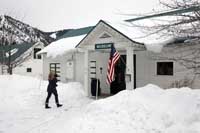Ketchum must find another way to protect downtown historic properties from development after the Idaho Supreme Court struck down an ordinance that would have served that purpose.
"The decision just took all the wind out of our sails," City Attorney Stephanie Bonney told the Planning and Zoning Commission at its Monday meeting. "Since July, we've been wrestling with this."
And, she said, none of their conjured-up solutions do everything city officials want.
The city's nullified ordinance permitted development rights to be transferred from historic properties to sites without historic significance. Transferring development rights, in itself, isn't illegal. Idaho code allows TDRs, but the court ruled in July that Ketchum's ordinance doesn't adhere to allowed uses of them.
"The statute is not intended to allow for the protection of historic properties," the court's opinion states.
Idaho code allows development rights to be transferred from properties to "preserve open space, protect wildlife habitat and critical areas, and enhance and maintain the rural character of lands with contiguity to agricultural lands." The court said the statute's intent is to preserve rural lands, not historic buildings in a city's core.
The court also said the city couldn't just pick and choose historic buildings within the downtown—as it had done—but must have uniform zoning, meaning an area of town could be designated historic but not individual properties plucked out of downtown.
But no area of town is historic and, Bonney said, the court was "not very instructive" on where to go from here. One of the more attractive options put forth by city staff is an incentive-based program, allowing developers to build more square footage than is allowed if they provide a "benefit" to the city. These agreements would need to be decided on a case-by-case basis. One such benefit could be a developer's paying the owner of a historic property to not develop it and in return being allowed to build an extra floor.
That's very similar to the project that brought this issue to the state Supreme Court to begin with—the Gallery 260 building proposed on the empty lot at the corner of Sun Valley Road and First Avenue.
KGF Development, owner of Copper Ridge condominiums across the alley from the Gallery 260 lot, filed a lawsuit after Ketchum allowed Gallery 260 to exceed the 40-foot maximum height permitted in the area and construct a 48-foot-tall building. Gallery 260 was allowed the extra 8 feet through the Ketchum TDR ordinance because it purchased a historic property's development rights.
Marty Goodman, a representative for Gallery 260's developer, said the Supreme Court's decision was "very discouraging" because developers now aren't able to build a fourth floor.
"[Without the fourth floor] we couldn't sell it for what it would cost us to build it," he said, mentioning that Ketchum's other requirements, such as providing affordable housing, have weighed it down.
The P&Z didn't discuss where to go from here but was just given an overview of the dilemma on Monday. It will return to the issue at its Feb. 14 meeting.
Trevon Milliard: tmilliard@mtexpress.com


 Forest Service Park is one of about two dozen Ketchum properties considered historic. Photo by David N. Seelig
Forest Service Park is one of about two dozen Ketchum properties considered historic. Photo by David N. Seelig



































